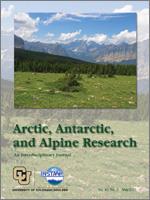Burrowing mammals often have considerable geomorphological impacts, and their tunneling activities may decrease the stability of landforms. We document the spatial distribution of Norwegian lemming burrows in a subarctic alpine meadow to determine the preferred locations for burrow entrances and to examine the potential for burrowing to decrease the stability of periglacial landforms at the site. Burrow entrances were disproportionately common into the base and sides of landforms (>68% of burrows), probably reflecting the lower energetic cost of moving soil horizontally, rather than vertically, out of burrows. Most burrow entrances (>60%) were also located under large rocks, which probably improve burrow stability by providing a firm ceiling to the entrance. Field observations show that these burrows are relatively stable, as only 3% were associated with any signs of increased erosion or landform instability. Therefore, in contrast to some previous studies, and despite burrowing being concentrated on landforms, we suggest that these rodents have little direct impact on landform integrity at this site.
How to translate text using browser tools
1 May 2011
Spatial Association of Lemming Burrows with Landforms in the Swedish Subarctic Mountains: Implications for Periglacial Feature Stability
Peter C. le Roux,
Jan Boelhouwers,
Jacqueline K. Davis,
Natalie S. Haussmann,
Elin J. Jantze,
K. Ian Meiklejohn





